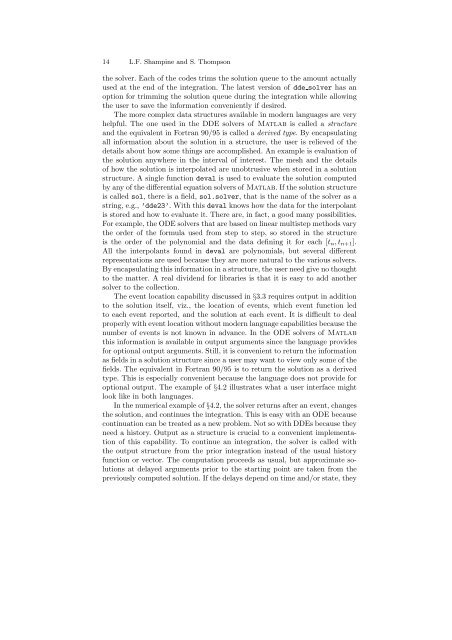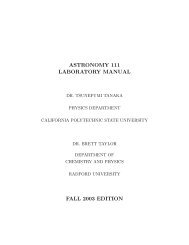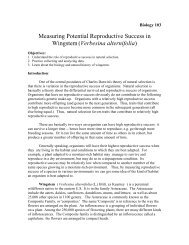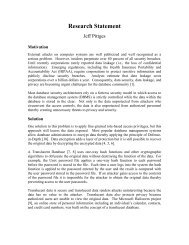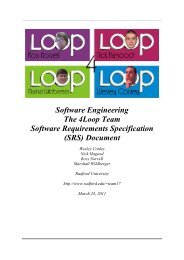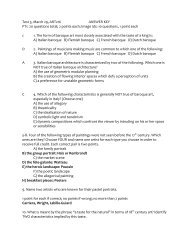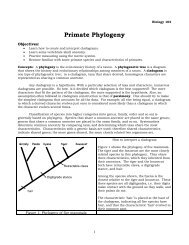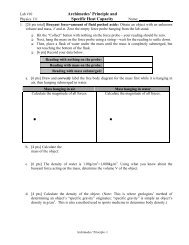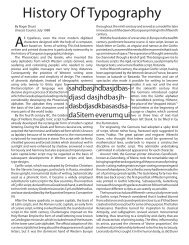Solving Delay Differential Equations - Radford University
Solving Delay Differential Equations - Radford University
Solving Delay Differential Equations - Radford University
You also want an ePaper? Increase the reach of your titles
YUMPU automatically turns print PDFs into web optimized ePapers that Google loves.
14 L.F. Shampine and S. Thompson<br />
the solver. Each of the codes trims the solution queue to the amount actually<br />
used at the end of the integration. The latest version of dde solver has an<br />
option for trimming the solution queue during the integration while allowing<br />
the user to save the information conveniently if desired.<br />
The more complex data structures available in modern languages are very<br />
helpful. The one used in the DDE solvers of Matlab is called a structure<br />
and the equivalent in Fortran 90/95 is called a derived type. By encapsulating<br />
all information about the solution in a structure, the user is relieved of the<br />
details about how some things are accomplished. An example is evaluation of<br />
the solution anywhere in the interval of interest. The mesh and the details<br />
of how the solution is interpolated are unobtrusive when stored in a solution<br />
structure. A single function deval is used to evaluate the solution computed<br />
by any of the differential equation solvers of Matlab. If the solution structure<br />
is called sol, there is a field, sol.solver, that is the name of the solver as a<br />
string, e.g., ’dde23’. With this deval knows how the data for the interpolant<br />
is stored and how to evaluate it. There are, in fact, a good many possibilities.<br />
For example, the ODE solvers that are based on linear multistep methods vary<br />
the order of the formula used from step to step, so stored in the structure<br />
is the order of the polynomial and the data defining it for each [tn, tn+1].<br />
All the interpolants found in deval are polynomials, but several different<br />
representations are used because they are more natural to the various solvers.<br />
By encapsulating this information in a structure, the user need give no thought<br />
to the matter. A real dividend for libraries is that it is easy to add another<br />
solver to the collection.<br />
The event location capability discussed in §3.3 requires output in addition<br />
to the solution itself, viz., the location of events, which event function led<br />
to each event reported, and the solution at each event. It is difficult to deal<br />
properly with event location without modern language capabilities because the<br />
number of events is not known in advance. In the ODE solvers of Matlab<br />
this information is available in output arguments since the language provides<br />
for optional output arguments. Still, it is convenient to return the information<br />
as fields in a solution structure since a user may want to view only some of the<br />
fields. The equivalent in Fortran 90/95 is to return the solution as a derived<br />
type. This is especially convenient because the language does not provide for<br />
optional output. The example of §4.2 illustrates what a user interface might<br />
look like in both languages.<br />
In the numerical example of §4.2, the solver returns after an event, changes<br />
the solution, and continues the integration. This is easy with an ODE because<br />
continuation can be treated as a new problem. Not so with DDEs because they<br />
need a history. Output as a structure is crucial to a convenient implementation<br />
of this capability. To continue an integration, the solver is called with<br />
the output structure from the prior integration instead of the usual history<br />
function or vector. The computation proceeds as usual, but approximate solutions<br />
at delayed arguments prior to the starting point are taken from the<br />
previously computed solution. If the delays depend on time and/or state, they


